WOMEN'S RIGHTS
Women Liberating Men
Women have always been primary influences
in the private life of their families, organizations, and communities.
They give birth to the children and attend to their early growth and development.
Much of the detailed work in every type
of institutional endeavour in society at large is done by women. With a
few notable exceptions, women had been excluded from the professions, other
than nursing and teaching, and from the public life of organizations and
communities as well as from the work of nations until the beginning of
this century. Anticipating a worldwide movement for the wide sharing of
human freedom, Canadian women had to engage in difficult legal proceedings
in the 1920s in order to overcome oppression and exploitation and to gain
legal status as "persons."

|
A widely known author
and leader in the Canadian women's suffrage movement early in the twentieth
century, Emily Murphy was th first woman in the British Empire to be appointed
a magistrate. A pioneer in the struggle for women's rights in Canada, she
led a decade-long campaign to have women declared legal 'persons' in 1929
[NAC/PA-138847] |
Early in the nineteenth century, thoughtful
Canadian women created local organizations for charitable and religious
purposes. They sought to help recently arrived immigrants and to assist
needy women and children at local levels. Gradually, women began to establish
organizations with broader regional and national objectives. Among these
were the Woman's Christian Temperance Union (WCTU) and the Toronto Women's
Literary Club, Canada's first suffrage group.
The WCTU, founded by Letitia Youmans, was
organized in Owen Sound, Ontario, in 1874. Its influence quickly spread
to other communities. The women who organized and carried forward its work
were deeply conscious of the profound problems that alcohol consumption
- the demon rum caused for wives and children for whom public agencies
provided little if any assistance.
The organizers of the WCTU believed that
alcohol was the primary source of many of the misfortunes that befell wives
and children in the latter years of the nineteenth century. During that
time primary industries such as agriculture, lumbering, and railway construction
were major sources of employment, and manufacturing and mining were developing.
Men employed in lumbering and mining camps were often away from their families
for weeks, sometimes months at a time. After prolonged periods in the bush,
many arrived home drunk and penniless. Their wives and children suffered.
This was one of a variety of reasons members of the WCTU campaigned for
prohibition of the production and sale of alcoholic beverages.
As the "White Ribbon Sisters" of the WCTU
became more knowledgeable concerning the conditions that existed in many
homes, their interest in reform widened. They began to campaign for mothers'
allowances and women's suffrage. Leaders of the WCTU began to realize that,
to effect the reforms they sought, women had to gain basic political rights.
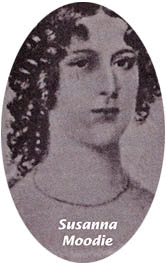 Women
virtually had no public role in early 19th century canada. Pioneering women
writers of the time, however, afford us an opportunity to witness first
hand what life then was like for them. Susanna Moodie, who witnessed the
effects of the 1832 Montreal cholera epidemic, wrote three acclaimed volumes,
all concerned with Canada: Roughing it in the Bush (1852), Life in the
Clearings (1853), and Flora Lindsay (1854). Her sister, Catherine Parr
Traill, was also a writer of distinction. Backwoods of Canada (1936) gave
an impressionistic account of settlers eking out an improvished existence
in the harsh hinterlands of Upper Canada. She also proved herself a gifted
botanist and artist with Canadian Wildflowers (1868) and Studies of Plant
Life in Canada (1885). Much of the writing by Canadian women in early 19th
century Canada took the form of letters, especially to family members or
friends. Some of these letters have been published this century, including
those of Anne Lengton who came to Canada in 1837. Her remarkable letters
provide valuable information about the events surrounding the Rebellion
of 1837 in Upper Canada. Similarly, Anna Jameson, travelling the same year
in Upper Canada, chronicled her eight-month stay there in Winter Studies
and Summer Rambles in Canada. Readers on both sides of the Atlantic were
attracted to this remarkable, independent woman's observation of pioneering
Upper Canadaian social life at an important time in Canadian history [Masters
and Fellows, Massey College]
Women
virtually had no public role in early 19th century canada. Pioneering women
writers of the time, however, afford us an opportunity to witness first
hand what life then was like for them. Susanna Moodie, who witnessed the
effects of the 1832 Montreal cholera epidemic, wrote three acclaimed volumes,
all concerned with Canada: Roughing it in the Bush (1852), Life in the
Clearings (1853), and Flora Lindsay (1854). Her sister, Catherine Parr
Traill, was also a writer of distinction. Backwoods of Canada (1936) gave
an impressionistic account of settlers eking out an improvished existence
in the harsh hinterlands of Upper Canada. She also proved herself a gifted
botanist and artist with Canadian Wildflowers (1868) and Studies of Plant
Life in Canada (1885). Much of the writing by Canadian women in early 19th
century Canada took the form of letters, especially to family members or
friends. Some of these letters have been published this century, including
those of Anne Lengton who came to Canada in 1837. Her remarkable letters
provide valuable information about the events surrounding the Rebellion
of 1837 in Upper Canada. Similarly, Anna Jameson, travelling the same year
in Upper Canada, chronicled her eight-month stay there in Winter Studies
and Summer Rambles in Canada. Readers on both sides of the Atlantic were
attracted to this remarkable, independent woman's observation of pioneering
Upper Canadaian social life at an important time in Canadian history [Masters
and Fellows, Massey College]
During the last quarter of the nineteenth
century small groups of women resolved to win for themselves and all Canadian
women the right to vote in provincial and federal elections. To secure
this right they embarked on what proved to be a long, difficult campaign.
Historically men had argued that the primary responsibility of women centred
in their homes. Many women agreed with them.

|
By the end of the nineteenth
century in Canada, women owning propery could vote in municipal elections.
The 1894 election solicited both "ladies and gentlemen" to vote in the
upcoming election being held on January 1 in the Ontario communities of
Meadowvale, Peel Country, and Goderich, Huron County [ NAC/C-9480] |
Politics it was argued, was a man's game
and was often dirty. Participants were bruised and hurt. To protect themselves,
women should keep out of politics. And most of them did. Thus the separation
continued between Canada's private life, in which women played primary
roles, and Canada's public life from which women were largely excluded.
ideas such as "no taxation without representation" gained the attention
of increasing numbers of women, those women who owned property began to
press for women's right to vote. It should be noted that, for most of the
first half of the nineteenth century women property holders in Quebec had
the right to vote in elections. But in 1849 they lost that right when the
Quebec Franchise Act was passed. In what is now Ontario, the situation
of women property owners at that time was the reverse of what it was in
Quebec. In the first half of the nineteenth century women property owners
in Ontario did not have provincial voting rights. After the middle of the
nineteenth century, Ontario women owning property had the right to vote
for educational officials at the local level. By the end of that century,
women owning property could vote in most municipal elections in Canada.
I n 1876, Dr., Emily Howard Stowe founded
the Toronto Women's Literary Club which became the first group in, Canada
committed to women's suffrage. She and her colleagues were aware that,
in the late 1860s, John Stuart Mill, the English utilitarian philosopher
and economist, had prepared- the first legislative bill for women's suffrage
in England.
Born in Norwich, in Upper Canada - now Ontario
- on May 1, 1831, Emily Stowe became a school teacher, but, as a result
of her husband's illness, resolved to become a medical doctor. Since Canadian
medical colleges would not accept a woman as a student, she sought and
gained admission to the New York Medical College for Women and graduated
in 1867. She became the first English-speaking Canadian woman to practise
medicine in Canada. At first she had to practise outside the law as she
was not granted a professional licence to practise medicine until 1880.
Through her own personal experience in gaining
acceptance as a medical doctor, she gained first-hand knowledge on which
to draw as she and her daughtet Dr. Ann Augusta Stowe-Gullen, the first
woman doctor trained in Canada, campaigned for voting rights for women.
By 1883 the Toronto Women's Literary Club had become the Toronto Women's
Suffrage Association. Then in 1889 it became the Dominion Women's Enfranchisement
Association. Prejudice against the granting of the franchise to women was
deeply rooted in the minds and traditions of members of provincial legislatures
and members of the Parliament of Canada. Opposition to the granting of
voting rights to women was also widespread in the general public until
the first quarter of the twentieth century.
During the last decade of the nineteenth
century, the WCTU made one of its objectives the securing of basic political
rights for women. These included the right to vote in provincial and federal
elections and to stand for election to provincial legislatures and the
House of Commons. Two decades of persistent efforts were required, however,
before -women began to enjoy these rights.
 On
January 28, 1916, women in the province of Manitoba were granted the right
to vote in provincial elections and to hold office as members of the Manitoba
Legislature. Women in Saskatchewan secured the same rights on March 14,
1916, and those in Alberta on April 19, 1916. British Columbia implemented
the same policy on April 5, 1917 and a week later on April 12, women in
Ontario were granted similar voting rights. Changes came more slowly in
Eastern Canada.
On
January 28, 1916, women in the province of Manitoba were granted the right
to vote in provincial elections and to hold office as members of the Manitoba
Legislature. Women in Saskatchewan secured the same rights on March 14,
1916, and those in Alberta on April 19, 1916. British Columbia implemented
the same policy on April 5, 1917 and a week later on April 12, women in
Ontario were granted similar voting rights. Changes came more slowly in
Eastern Canada.
Women in Nova Scotia were granted the right
to vote provincially and to stand for election to the legislature on April
26, 1918. Similar laws were passed in Prince Edward Island on May 3, 1922
and in Newfoundland on April 13, 1925. Women were given the right to vote
in provincial elections in New Brunswick on April 17, 1919, but it was
not until March 9, 1934 that they gained the right to stand for provincial
office.
Through the dedicated leadership of Therese
Casgrain, who campaigned thoughtfully and ceaselessly on behalf of women,
the Quebec Legislature finally gave women the right to vote in provincial
elections on April 25, 1940.
By that time Canadian women had been exercising
the right to vote in federal elections for more than twenty years. On May
24, 1918, all female citizens of Canada over the age of 21 were allowed
to vote in federal elections whether or not they had the right to vote
in provincial elections. Later, in, July 1919, they were allowed to stand
for election to the House of Commons but were denied the right to sit in
the Canadian Senate until 1929.
One of the key leaders in the campaign to
secure for Canadian women the legal right to sit in the Senate of Canada
was Emily Murphy, a writer, journalist, and magistrate. She was supported,
in her ten-year campaign to have women declared "persons" under the British
North America Act (and thus eligible to sit in the Senate of Canada), by
four other Alberta women, One of these was Nellie McClung, a highly effective
advocate. Her career merits special attention.
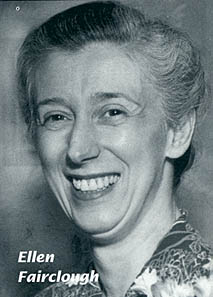 By
the 1920s, when she joined Emily Murphy in the struggle to ensure that
women were declared "persons" under the British North America Act, Nellie
McClung was widely known in Canada as an author, lecturer, and social reformer.
She had grown up with the early movement for women's rights. Born Nellie
Mooney on October 20, 1873, in Chatsworth, just south of Owen Sound, Ontario,
where the WCTU had originated, she moved with her family when she was seven
years old to a homestead in the Souris Valley, Brandon, Manitoba. Although
she did not begin her formal schooling until she was ten years old, she
made excellent progress and secured an elementary teaching certificate
when she was 16.
By
the 1920s, when she joined Emily Murphy in the struggle to ensure that
women were declared "persons" under the British North America Act, Nellie
McClung was widely known in Canada as an author, lecturer, and social reformer.
She had grown up with the early movement for women's rights. Born Nellie
Mooney on October 20, 1873, in Chatsworth, just south of Owen Sound, Ontario,
where the WCTU had originated, she moved with her family when she was seven
years old to a homestead in the Souris Valley, Brandon, Manitoba. Although
she did not begin her formal schooling until she was ten years old, she
made excellent progress and secured an elementary teaching certificate
when she was 16.
In 1896 after teaching for six years, she
married a Manitoba druggist, Robert Wesley McClung. Since her motherin-law
was the President of the WCTU in Manitoba, it was not long before Nellie
became one of its key members. The WCTU had been brought into being by
women whose religious convictions Nellie McClung shared. Thus she had a
natural interest in its activities and dedicated herself to realizing its
objectives.
A primary objective of the WCTU was the
legal prohibition of the manufacture, sale, and distribution of alcoholic
beverages on the grounds that such beverages were destructive of individual,
family, and social life. Prohibition was finally approved in Canada during
World War I. Since many women had suffered and were suffering grievously
as a result of alcoholism and its concomitants, they were determined, against
great odds, that prohibition should continue.
The work of the WCTU, while important to
Nellie McClung, had not been her only interest. She and her husband were
busy bringing up their children and Nellie devoted time to writing. Her
first novel, Sewing Seeds in Danny, a witty description of a small town
in Western Canada, was published in 1908. It quickly gained popular attention
and soon became a best-seller. Three years after its appearance she and
her husband moved to Winnipeg where she gave birth to her fifth child.
In Winnipeg Nellie was soon in demand as
a speaker to women's rights groups and to reform organizations. Members
of the Liberal Party persuaded her to share in their efforts to reform
Manitoba's political life which was then dominated by the Conservative
Government led by Sir Rodmond Roblin. In the midst of her reform efforts
in Manitoba, however, she and her husband and family moved to Edmonton,
Alberta. There she found many opportunities to continue her activities.
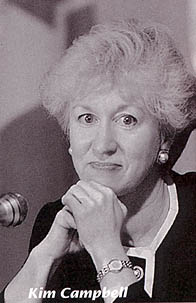 As
her reputation as an author and lecturer spread, she received many invitations
to speak publicly. :'In 1921 she lectured widely in England where she was
enthusiastically received by her audiences. That same year she was elected
as a Liberal member of the Alberta Legislature for Edmonton and served
there from 1921 until 1926. Later in the 1930s she served as a member of
the first Board of Governors of the Canadian Broadcasting Corporation and
was a delegate to the League of Nations in 1938.
As
her reputation as an author and lecturer spread, she received many invitations
to speak publicly. :'In 1921 she lectured widely in England where she was
enthusiastically received by her audiences. That same year she was elected
as a Liberal member of the Alberta Legislature for Edmonton and served
there from 1921 until 1926. Later in the 1930s she served as a member of
the first Board of Governors of the Canadian Broadcasting Corporation and
was a delegate to the League of Nations in 1938.
Nellie McClung was, of course, only one
of a considerable number of women who made important contributions to the
winning of political rights for women and to the general improvement of
the status of women. Her friend, Agnes McPhail, had a
much longer career as an elected representatives of the people. She was
a member of the House of Commons in Ottawa from 1921 until 1940 and was
a member of the Ontario Legislature from 1943 until 1945 and again from
1948 until 1951. Nonetheless as a teacher, an advocate of women's rights,
a reformer, an author, and member of the Alberta Legislature, Nellie McClung
made a comprehensive contribution to the achievement of political rights
for Canadian women.
When Nellie McClung died in Victoria, British
Columbia, on September 1, 1951, major advances had been made in the widening
of political opportunities for women and the redefinition of their place
in Canadian society. But much remained to be done. Further progress was
made in 1957 when Ellen Fairclough was appointed Secretary of State of
Canada in the Cabinet of Prime Minister John Diefenbaker. As a member of
the Federal Cabinet, Mrs. Fairclough shared in the executive authority
that governs Canada at its highest levels. As Canada's first woman Cabinet
Minister, Mrs. Fairclough was a key contributor in the winning of essential
political rights for Canadian women. Finally, in 1993, Canada's first female
Prime Minister, Kim Campbell, received the seals of office. Her appointment
came at a most difficult political and economic time and she and her government
were soon defeated in the federal election of October 1993. But a woman
had served in the highest political office in Canada. This was yet another
key step in the winning of political rights for women in Canada, indeed
in the world. Reflecting a global trend since World War 1, the traditional
exclusion of women from political office has slowly come to an end
not just in Canada but worldwide. The election of such world leaders as
Margaret Thatcher, Golda Meir, Benazir Bhutto, Mary Robinson, Gor Harlem
Brandtland, and Indira Ghandi clearly demonstrates this dramatic development.
But the need to strengthen the base and
widen opportunities for women continues.

 Women
virtually had no public role in early 19th century canada. Pioneering women
writers of the time, however, afford us an opportunity to witness first
hand what life then was like for them. Susanna Moodie, who witnessed the
effects of the 1832 Montreal cholera epidemic, wrote three acclaimed volumes,
all concerned with Canada: Roughing it in the Bush (1852), Life in the
Clearings (1853), and Flora Lindsay (1854). Her sister, Catherine Parr
Traill, was also a writer of distinction. Backwoods of Canada (1936) gave
an impressionistic account of settlers eking out an improvished existence
in the harsh hinterlands of Upper Canada. She also proved herself a gifted
botanist and artist with Canadian Wildflowers (1868) and Studies of Plant
Life in Canada (1885). Much of the writing by Canadian women in early 19th
century Canada took the form of letters, especially to family members or
friends. Some of these letters have been published this century, including
those of Anne Lengton who came to Canada in 1837. Her remarkable letters
provide valuable information about the events surrounding the Rebellion
of 1837 in Upper Canada. Similarly, Anna Jameson, travelling the same year
in Upper Canada, chronicled her eight-month stay there in Winter Studies
and Summer Rambles in Canada. Readers on both sides of the Atlantic were
attracted to this remarkable, independent woman's observation of pioneering
Upper Canadaian social life at an important time in Canadian history [Masters
and Fellows, Massey College]
Women
virtually had no public role in early 19th century canada. Pioneering women
writers of the time, however, afford us an opportunity to witness first
hand what life then was like for them. Susanna Moodie, who witnessed the
effects of the 1832 Montreal cholera epidemic, wrote three acclaimed volumes,
all concerned with Canada: Roughing it in the Bush (1852), Life in the
Clearings (1853), and Flora Lindsay (1854). Her sister, Catherine Parr
Traill, was also a writer of distinction. Backwoods of Canada (1936) gave
an impressionistic account of settlers eking out an improvished existence
in the harsh hinterlands of Upper Canada. She also proved herself a gifted
botanist and artist with Canadian Wildflowers (1868) and Studies of Plant
Life in Canada (1885). Much of the writing by Canadian women in early 19th
century Canada took the form of letters, especially to family members or
friends. Some of these letters have been published this century, including
those of Anne Lengton who came to Canada in 1837. Her remarkable letters
provide valuable information about the events surrounding the Rebellion
of 1837 in Upper Canada. Similarly, Anna Jameson, travelling the same year
in Upper Canada, chronicled her eight-month stay there in Winter Studies
and Summer Rambles in Canada. Readers on both sides of the Atlantic were
attracted to this remarkable, independent woman's observation of pioneering
Upper Canadaian social life at an important time in Canadian history [Masters
and Fellows, Massey College]

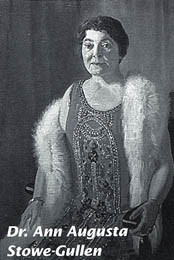
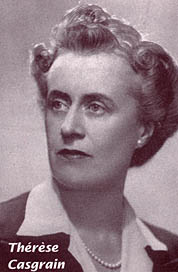
 On
January 28, 1916, women in the province of Manitoba were granted the right
to vote in provincial elections and to hold office as members of the Manitoba
Legislature. Women in Saskatchewan secured the same rights on March 14,
1916, and those in Alberta on April 19, 1916. British Columbia implemented
the same policy on April 5, 1917 and a week later on April 12, women in
Ontario were granted similar voting rights. Changes came more slowly in
Eastern Canada.
On
January 28, 1916, women in the province of Manitoba were granted the right
to vote in provincial elections and to hold office as members of the Manitoba
Legislature. Women in Saskatchewan secured the same rights on March 14,
1916, and those in Alberta on April 19, 1916. British Columbia implemented
the same policy on April 5, 1917 and a week later on April 12, women in
Ontario were granted similar voting rights. Changes came more slowly in
Eastern Canada.
 By
the 1920s, when she joined Emily Murphy in the struggle to ensure that
women were declared "persons" under the British North America Act, Nellie
McClung was widely known in Canada as an author, lecturer, and social reformer.
She had grown up with the early movement for women's rights. Born Nellie
Mooney on October 20, 1873, in Chatsworth, just south of Owen Sound, Ontario,
where the WCTU had originated, she moved with her family when she was seven
years old to a homestead in the Souris Valley, Brandon, Manitoba. Although
she did not begin her formal schooling until she was ten years old, she
made excellent progress and secured an elementary teaching certificate
when she was 16.
By
the 1920s, when she joined Emily Murphy in the struggle to ensure that
women were declared "persons" under the British North America Act, Nellie
McClung was widely known in Canada as an author, lecturer, and social reformer.
She had grown up with the early movement for women's rights. Born Nellie
Mooney on October 20, 1873, in Chatsworth, just south of Owen Sound, Ontario,
where the WCTU had originated, she moved with her family when she was seven
years old to a homestead in the Souris Valley, Brandon, Manitoba. Although
she did not begin her formal schooling until she was ten years old, she
made excellent progress and secured an elementary teaching certificate
when she was 16.
 As
her reputation as an author and lecturer spread, she received many invitations
to speak publicly. :'In 1921 she lectured widely in England where she was
enthusiastically received by her audiences. That same year she was elected
as a Liberal member of the Alberta Legislature for Edmonton and served
there from 1921 until 1926. Later in the 1930s she served as a member of
the first Board of Governors of the Canadian Broadcasting Corporation and
was a delegate to the League of Nations in 1938.
As
her reputation as an author and lecturer spread, she received many invitations
to speak publicly. :'In 1921 she lectured widely in England where she was
enthusiastically received by her audiences. That same year she was elected
as a Liberal member of the Alberta Legislature for Edmonton and served
there from 1921 until 1926. Later in the 1930s she served as a member of
the first Board of Governors of the Canadian Broadcasting Corporation and
was a delegate to the League of Nations in 1938.